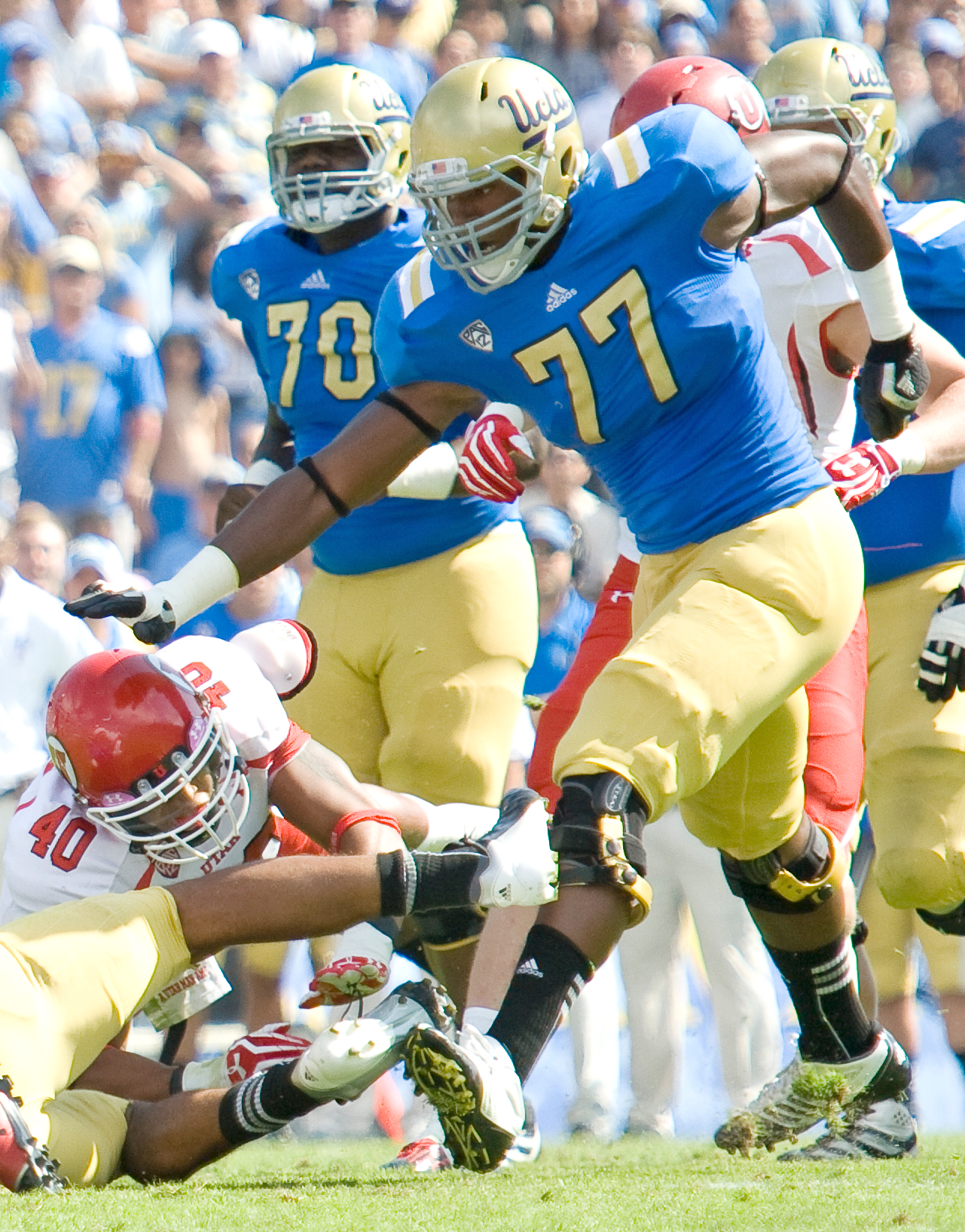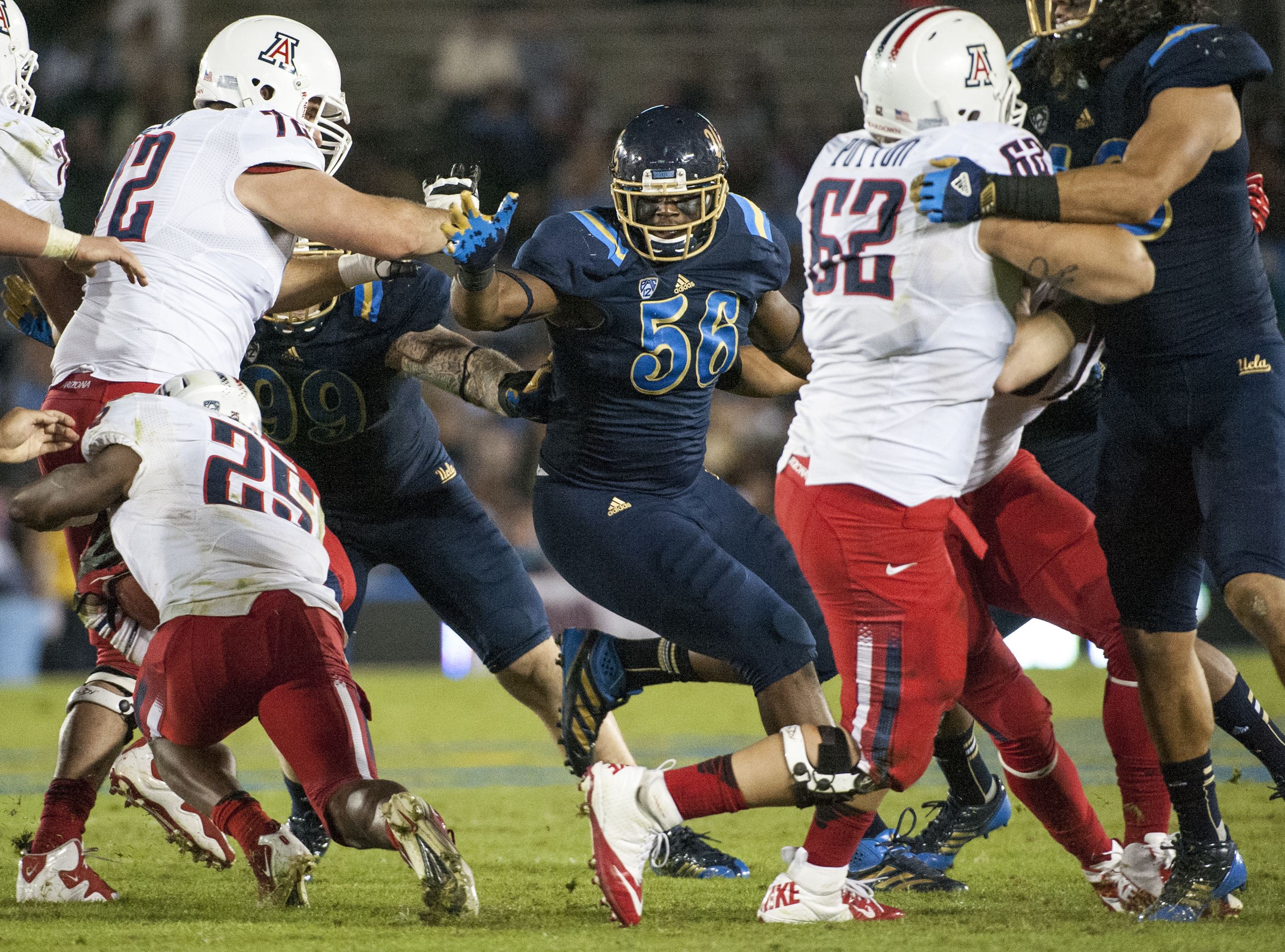
After initially committing to the Trojans on a TV broadcast, redshirt freshman offensive tackle Torian White ended up signing with the Bruins.
Torian White fitted a USC cap onto his head during a televised commitment ceremony, signifying his choice to become a Trojan. The moderator congratulated him as his parents stood in support, throwing up two fingers and proclaiming, “Fight On.”
While White and his family smiled and cheered in celebration, the look of disdain on White’s younger brother’s face said it all.
“He knew I wanted to be a Bruin,” White said. “My family had their opinions and I had mine, and eventually, it came down to me making a decision for myself.”
Following the ceremony, he went home and faxed in his letter of intent to UCLA, officially declaring himself a Bruin.
White, now a redshirt freshman offensive tackle, had originally committed to UCLA in June before his senior year after receiving an offer from the Bruins.
White accepted the UCLA offer almost immediately due in part to the timing: It was Father’s Day.
“I had never seen a prouder look on my dad’s face than after I got that offer,” White said. “With the timing and everything, I committed right away. I knew this was the best place for me, and I fell in love with it.”
Despite White’s love of UCLA, over 30 schools ended up offering the 6-foot-7-inch, 285-pound tackle ““ including USC.
“The coaches at USC were coming after me really hard,” White said. “They said I was one of their top linemen on the board, and they wanted me to go there.”
White decided to take an official visit to USC the week before signing day, which caused him to question his initial decision.
“That week before signing day was one of the most stressful weeks of my life,” White said.
“I had so many different things going through my head. I had no idea where I was going to go, but I’m glad I ended up at UCLA.”
Two years after the ceremony where he donned that cardinal and gold hat, White is UCLA’s starting left tackle and he will face the team he once believed to be his own in the Rose Bowl.
White is one of 18 Bruins who were offered by the Trojans in high school, and he is not the only one who considered representing USC.
Full circle … or square
As a sophomore in high school, freshman receiver Jordan Payton was already one of the top prospects for the 2012 recruiting class. Payton had almost 20 offers and, during the spring of his sophomore year, he committed to USC.
“I grew up right down the street from USC, and that was the school, that was the big-time,” Payton said. “When they offered me, I said, “˜Why not take it and stay local?'”
Payton remained committed for over a year before he opened up his recruitment.
What followed was possibly one of the most talked about and criticized recruiting process in recent history.
Payton visited Arizona State, California, Michigan and Notre Dame before committing to Cal on a nationally televised broadcast during the U.S. Army All-American Bowl.
“We all got caught up in the hype,” Payton said. “Everyone was saying, “˜Let’s all go to Cal,’ and then it was a snowball effect from there.”
Payton was not finished there, as he later committed to Washington the night before signing day, following Cal’s former receivers coach, who left Cal for Washington after the All-American Bowl.
After a night of thinking, Payton came full-circle and decided to stay in Los Angeles. But this time, it was at UCLA, not USC.
“Right from when the new coaching staff arrived at UCLA, I had a feeling I was going to go here,” Payton said. “In my mind, I knew that I would end up at UCLA, and committing here was one of the best things I’ve ever done.”
Through the circus of his recruitment, Payton learned his fair share of valuable lessons and he has no regrets.
“The right answer would be to say that I probably shouldn’t have committed everywhere,” Payton said. “But at the time I was going through so much and it helped me a lot as a person. I wouldn’t trade that experience for anything.”
The other side
Throughout his recruitment, USC’s redshirt sophomore linebacker Hayes Pullard thought he would be a UCLA Bruin.
Hailing from Crenshaw High School, which produced UCLA greats like Brian Price and Reggie Carter, Pullard was ready to be next in line.
Then USC offered.
“The tradition and history of the program was hard to pass up,” Pullard said. “Especially with what some of their linebackers had done recently. I wanted to follow in their footsteps.”
The offer from USC itself was not the biggest factor for Pullard, though. His father, who passed away before he made his decision, had always been a big Trojan supporter.
“My dad was always telling me to go to USC growing up,” Pullard said. “I would tell him I think I’m going to UCLA, but as I got older I realized that USC was the best place for me.”
Committing to the future
During a one-week span in March of 2007, UCLA received nine commitments for the 2008 recruiting class.
They were hailed as the group that would turn UCLA around, put the Bruins back on the map, take the program to the next level.
“It was special because we knew we had something great,” said redshirt senior defensive end Datone Jones, who is one of five remaining players from that group. “We were all top guys at our positions and we forged a tight bond through the recruiting process.”
Jones’ decision to be a part of that original commitment group came as a slight surprise considering USC’s national prominence along with the fact that the Trojans were his first offer.
“If you lived in Los Angeles, that was the school to go to,” Jones said. “They were rolling with Clay Matthews and Reggie Bush and those guys, but I opened my eyes up and saw that UCLA was the better school for me.”
While that recruiting class was supposed to change the landscape of college football in Los Angeles, the 2008 recruiting class still has yet to beat USC.
This is something that the Bruins, Jones especially, keep in mind.
“We made a commitment to each other that we were going to turn this program around,” Jones said. “And here we are, five years later, with a chance to do something really special. We can do something that people haven’t seen in a long time.”
